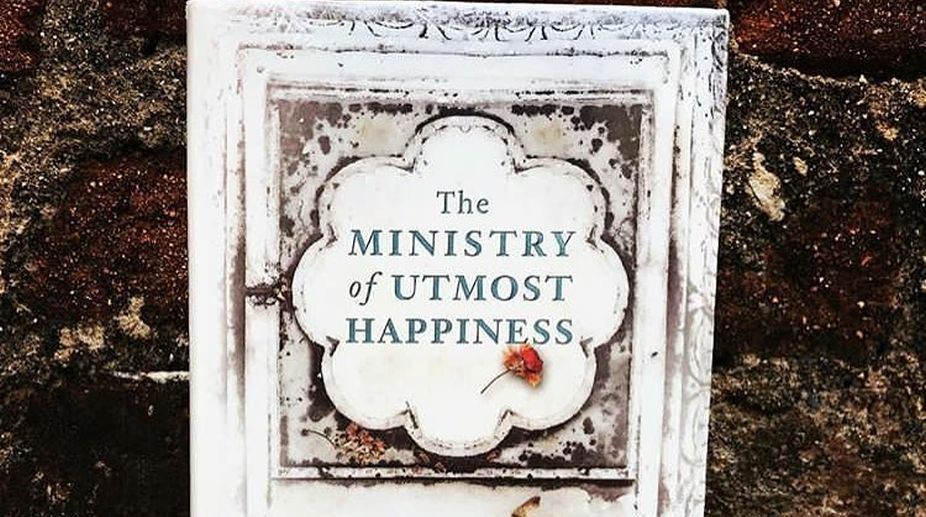Over the years vultures, the true custodians of death, stopped flapping their wings as the country feasted more on “ice cream, butterscotch crunch, nutty buddy, chocolate chips and more mango milkshake”, stirring up the putrid time inside, thereby ensuring cows had a sanctum sanctorum, that this country was gradually to become.
“At an ostensibly magic hour when the day departed and darkness unhinged itself from the branches of the old tree in an old graveyard, long deserted by the sparrows, may be they too died of diclofenacs, which by the way proved to be very nourishing for the cows, strengthening them from muscle to muscle, and over the time became the most trusted vulture bait making feathered friends droop and drool and silently die.” Anjum, however, struck an uncanny friendship with these ghosts, rejected by theduniya, and found out they were not altogether unhappy about exiting the story and seek shelter in her Khawbgah, her “Ministry of Utmost Happiness”.
She, a hermaphrodite, is twice removed from reality and thrice as close to it, for she belongs to a world of her own that has been routinely scrutinised by critics (political or otherwise) as unsuitable and unfitting like that of her ardent architect Arundhati Roy.
In the dawn of chapters and at a less brutal juncture of the book, Anjum, the man desiring to be a woman, a victim of misplaced biology, and a free spirit who is what she is as she thinks that she is what she is, professes, “Who says I’m Anjum, I am Anjuman. I am a mehfil, I am a gathering. Of everybody and nobody, of everything and nothing.”
Bordering on the slightly parochial, Roy’sThe Ministry of Utmost Happiness elevates itself above any genre and yet at heart it’s a novel, a work of fiction, by being which it tells truths that other truths can’t reveal.
The pages that unfold are turbulent, noisy, cruel, crowded, unorthodox, and at times loving. The story has mainly two strings attached to it, one the life and times of Anjum, caught between the eternal battle of “to be or not to be” only to realise she has always been there, an omnipresence, in whatever form; and the other the architect-turned-activist Tilottoma (reminiscing of Roy herself) and her turbulent entity in love and loathing. As in her debut fiction The God of Small Things, the second one after a hiatus of 20 odd years is more than just magic realism. It’s a tale told by an eyewitness – eyewitnesses — a novel dedicated to telling the story of a multitude. Keeping true to the novelistic characteristic of a central narrative,“The Ministry” pushes its way through a crowd of other stories, bumping into stories in; an emergency India, a vulnerable Valley, weeping Woods, in the streets; occasionally stepping over them because they are sleeping on the sidewalk, in the constant fear of being run over, which, they have been, and yet they continue to live in paralysed physicalities or whatever.
It’s a story of and for the “unconsoled”, starting and ending in a graveyard, unapologetically political, a testament of truth as was evident in Roy’s other writings The Algebra of Infinite Justice andWalking with the Comrades. The fact this specimen of truthful encounters has been wrapped in the form of fiction, itself points to the mindset of the author who didn’t want to conform to the specifics of any genre.
Rightfully so, the turn of events have been projected as they are and everything that is right and wrong with the country.The basic story is never confusing or complex, rather very straightforward, the characters are just conflicted between their commitments to a nation in which there are doctrinal elements telling them everything they are doing is wrong and their commitment to living life as they want to unhindered and ungoverned.
Starting from the sordid tales of partition, to human bombs blowing up in practically every corner of the earth, the failure that’s Kashmir, and a dream of the utopian, Roy has covered it all. In her ordinarily unusual world everyone is a dreamer of what should be and a defiant for what should be not. There are animals entering into a peaceful living with humans, who live with the dead, for ghosts too are friendly here.Therefore, a kitten needs no permission to take on the Army when they whimsically decide to drown it. In an act of defiance it bares its fangs as resident Guih Kyom, a dung beetle lies pointing his feet to the sky, lest it comes crumbling down.
Roy devises her lexicon which is truer than fictional. These are words that the duniya knows, words which you hear in the vast lairs of powers, in the unheard cries of widows, mothers, orphans, missing, misinterpreted, killed ~ the unconsoled. Yet, language is seemingly not a barrier for this novel which extending beyond the realms of Urdu, Hindi and English, remains mainly a language of offering. In a critical crux of the narrative she reminds the audience with the already familiarised terms through her dictionary of assault bearing terms like Ammunition, Bullet, Crossfire, Disappeared, Encounter, Funerals etc in the usual alphabetical order, appealing to anyone capable of some reason, inviting them to take part in the pandemonium of sorrow that has even left the alphabets traumatised.
The novel excels through repetitions a tried and tested method of Roy. These reiterations throw a specific spell on the perusers. She utilises irregular redundancy as a phonetic expressive gadget. For example “Women are not allowed, women are not allowed, women are not allowed,” which is repeated in that order twice in the novel, pointing to the greater need of any fictional piece to use such repetitions, the artistic liberty and the veritable truth that history needs to be retold for everyone and to anyone who is again capable of reason.
Though the basic premise is nothing that the readers are not hitherto acquainted with, it is Roy’s keen imaging of places that renders the prose with a fictional quality. From picturing the dingy lanes of Delhi to a beautiful Dal Lake rendered unattractive due to the numerous cigarette butts floating on it, an expression of anxious moments and people spending nights on sleepless pillows, decorate the novel with the necessary staleness that the story demands. Description of filth enters and leaves the novel at points almost suffocating the reader into empathising with the pathos of characters.
The linguistic liberties make the writing look like a fascinating mess in which characters hurdle together to find voices of their own which often go unheard. It takes enormous belief to convince oneself that he or she is on the right side of history and more so if the person is a creative one whose faculty is subject to judgments and more often invite criticisms that tendto write off the art. Roy has struck that chord here, never mincing words for one, telling the tales as they demand to be told, and after a point of time the tales start telling themselves as voices start resonating “loud, loud and louder”.
“The Ministry” is not a novel and yet it is in all its novelty, the stuff that great novels are made of. Much like Roy, it screams, it screams of troubled times, it strives to pull down the armoured doors in the corridors of power, points at wrongdoings which are visible in a decrepit light, only that most are too scared to talk about them. Yet, some do hoping against hope which Roy brilliantly conjures up in, “with earth in clenched fists and mustard flowers growing through his fingers.” Roy’s story is formless and shapeless just so as you know it aims at one uniform shape of humanity, love which is not an easy story to narrate in today’s times. The graveyard in the book cover but promises happiness a happiness which is not happy altogether, as strewn together are details in death and despair and calls for appreciation in “every coronation, war, massacre, victory and defeat.”
The reviewer is Assistant Professor, The Statesman Print Journalism School











